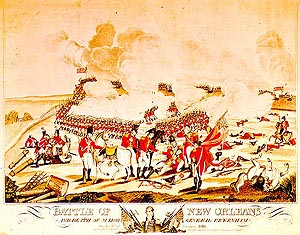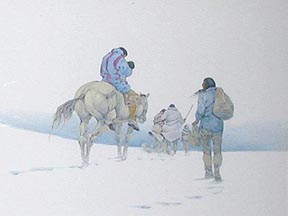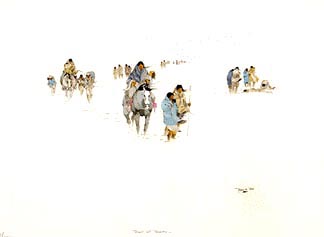|
Louis Durant's cattle created quite a stir. The Choctaw had never seen cattle before, and they were fascinated! Many stories were told for years about what some had done when they first saw cattle. Before many years passed, however, a lot of Choctaw were raising cattle. Each of the three Frenchmen married full-blood Choctaw women, settled into life in the midst of these Indians and began to raise families. Louis Durant had a full life among the Choctaw; he married She Ni Yak, a Choctaw, and he raised three strong sons (Pierre, Charles and Lewis), along with two daughters, Margaret and Cillen (or Syllan or Sillen) . He built a large home high atop a bluff overlooking the Big Black River in Yazoo County, and he helped the Choctaw with advice when they had growing problems dealing with the U.S. Government. Louis Durant (along with the LeFlore brothers) were adopted into the Choctaw Tribe. Durant was adopted into the Hanaka Iska Clan. He was highly respected by the Choctaws for his help and for his honesty. He was paid for his work on the treaty negotiations of 1826. When the War of 1812 broke out, Louis quickly joined in, leading a detachment of Choctaw troops, where he served under the great Chief Pushmataha, for General Andrew Jackson in The Battle of New Orleans. After the war was over, he was forever called Captain Durant.
Pierre Durant, Louis' son, took over the affairs of the family as his father aged. Pierre married a Choctaw bride, and the family holdings increased to more than 7,000 acres of land, in total. Louis Durant had a full life among the Choctaw, and he raised three strong sons (Pierre, Charles and Lewis), along with two daughters, Margaret and Cillen (or Syllan or Sillen) . He built a large home high atop a bluff overlooking the Big Black River in Yazoo County, and he helped the Choctaw with advice when they had growing problems dealing with the U.S. Government. Louis Durant (along with the LeFlore brothers) were adopted into the Choctaw Tribe. Durant was adopted into the Hanaka Iska Clan. He was highly respected by the Choctaws for his help and for his honesty. He was dubbed "The progenitor of the Choctaw Durants" by the Choctaw Tribe. When the War of 1812 broke out, Louis quickly joined in, leading a detachment of Choctaw troops (which included his three sons), where he served under the great Chief Pushmataha, for General Andrew Jackson in The Battle of New Orleans. After the war was over, he was called Captain Durant for the rest of his life. When a town began to grow below his home and across the Big Black River, the surveyors met to decide what to name the town. Out of respect for old Captain Durant, they decided to name the town Durant, Mississippi. This was just the first of two towns to be named after his family. After Mississippi was a state, Holmes County was created from this area of Yazoo County, where Durant is still a town. Relatives and friends all fought in the Civil War, mostly on the Confederate side. Pierre Durant, Louis' son, took over the affairs of the family as his father aged. Pierre married a Choctaw bride named Rachel, and his brothers married also; the family holdings increased to more than 7,000 acres of land, in total by the 1840's. After the signing of the Treaty of Dancing Rabbit Creek in
1830, the Choctaw were "removed" for the most part, to When removal to Indian Territory became a fact, Pierre,
his father, and much of their extended family opted out of leaving
Mississippi. However, they had not counted on the mood of the
Americans who would move into their The book contains a graphic account of the 1845 journey of Pierre with his family, overland from Bogue Chitto, Neshoba County to Chickasaw Bluffs on the Yazoo River just north of Vicksburg, where they boarded the steamboat Erin for the five-day trip up the Mississippi River to Arkansas Post, hence up the Arkansas River to Fort Coffee near present day Fort Smith, then to Sculleyville (about five miles from Fort Coffee). Some of his sons settled near Sculleyville in the present-day city of Poteau, Oklahoma. Pierre and the rest of the family headed for Harse Prairie (two miles northeast of the present-day town of Hugo, Oklahoma), via the Army Road that went through Horse Prairie, 25 miles further east to Doaksville (near present-day Fort Towson). At Horse Prairie there was a large settlement of over two hundred log cabins and shacks built closely together. There was also a trading post and a clearinghouse (a store that dealt in farm commodities, similar to a farmer's co-op). Pierre settled with his second wife Sophia and his two daughters, about 1.5 miles northeast of present-day Bennington, Oklahoma. George and Sylvester built their homes and farmed about a mile north of Pierre. Fisher took his family and settled about 25 miles further west, in Carriage Point (two miles south of present-day Durant, Oklahoma. This was the beginning of the town of Durant, Oklahoma. It was the second town (of the same name) that was named for Durant family members. With the marriage of Pierre's daughter Monette to John Folsom about 1830, the Folsom and Durant lines of our family history merge into one. And, the marriage of Monette and John Folsom's child, John Jr., to Benettie Durant, further solidifies that merging. John Folsom's brother was David Folsom, a chief of the Choctaw. David Folsom was a very important person to his tribe, and worked for them for many years. You can read more about his important contributions here.
In the next two generations, their granddaughter Lucinda married Ben Hampton, to tie in another important Choctaw family line. Ben Hampton was just one of many Hampton family members who were well respected and well liked by those in his tribe. Our Ben (there were several), was the son of Nicholas Hampton and was chosen to sit on the council for the Atoka Treaty, with the DAWES Commission, to help his tribe keep as much as he could in the negotiations. He signed that treaty with the others. To read the treaty, go to: Atoka Treaty Photo, right: Lucinda Hampton9 (Burke), daughter of Ben Hampton2 and Charlotte Folsom8, and my great-great grandmother.
I want to express my heartfelt thanks to Dennis Boswell, genealogist, for his help in providing details on the Durant family. He has been invaluable in providing information from the family book mentioned above, and the following other sources: History of
the Choctaw, Chickasaw and Natchez Indians by H.B.
Cushman, published in 1899;
On to the Durant Family Lineage Or, back to LIST Copyright
2002, all rights reserved
|

 When a town began to grow below his home and across the
Big Black River, the surveyors met to decide what to call the town.
Out of respect for old Captain Durant, they decided to name the town
Durant, Mississippi. This was just the first of two towns to be named
after his family. After Mississippi was a state, Holmes County was
created from this area of Yazoo County, where Durant is still a town.
When a town began to grow below his home and across the
Big Black River, the surveyors met to decide what to call the town.
Out of respect for old Captain Durant, they decided to name the town
Durant, Mississippi. This was just the first of two towns to be named
after his family. After Mississippi was a state, Holmes County was
created from this area of Yazoo County, where Durant is still a town. the new Indian Territory made for them west of the Mississippi. They
were taken in groups over the trail, many on foot, during winter months,
and disease and death ran rampant through the tribe as they were not given
enough time in which to care for their sick and dying family
members. It was an atrocity that has never been repeated in the
history of this country. There is not even any documentation as to how
many Choctaw lost their lives during this trip, called the Trail of Tears.
I am going to include two paintings which depict it well, both done by
Choctaw artist Jerome Tiger. You can see more of his art
at:
the new Indian Territory made for them west of the Mississippi. They
were taken in groups over the trail, many on foot, during winter months,
and disease and death ran rampant through the tribe as they were not given
enough time in which to care for their sick and dying family
members. It was an atrocity that has never been repeated in the
history of this country. There is not even any documentation as to how
many Choctaw lost their lives during this trip, called the Trail of Tears.
I am going to include two paintings which depict it well, both done by
Choctaw artist Jerome Tiger. You can see more of his art
at:  country.
These people were jealous of the success of this family, and the
harassment they were subjected to, along with the changes that came after
most of the Choctaw left, soon made living in the land they had always
loved, unbearable. Pierre and the rest of his family divested
themselves of most of their property and belongings, took the seal his
father had fashioned for the Durant family, emblazoned it on eight wagons,
and loaded them up with his father and his family, for the long trip to
Indian Territory. They left December 30, 1844, and arrived there in
March 20,1845. One of Pierre Durant's descendants (Randle Durant),
wrote a book titled Footsteps
of the Choctaw Durants, in which he used the notes and journals
of Pierre Durant to document their history. I am told it is "...a
personal family history; a struggle to try and remain in their homeland,
mistreatment by the government; a painful and sad journey."
country.
These people were jealous of the success of this family, and the
harassment they were subjected to, along with the changes that came after
most of the Choctaw left, soon made living in the land they had always
loved, unbearable. Pierre and the rest of his family divested
themselves of most of their property and belongings, took the seal his
father had fashioned for the Durant family, emblazoned it on eight wagons,
and loaded them up with his father and his family, for the long trip to
Indian Territory. They left December 30, 1844, and arrived there in
March 20,1845. One of Pierre Durant's descendants (Randle Durant),
wrote a book titled Footsteps
of the Choctaw Durants, in which he used the notes and journals
of Pierre Durant to document their history. I am told it is "...a
personal family history; a struggle to try and remain in their homeland,
mistreatment by the government; a painful and sad journey."


